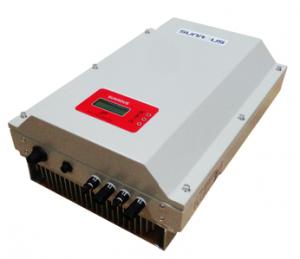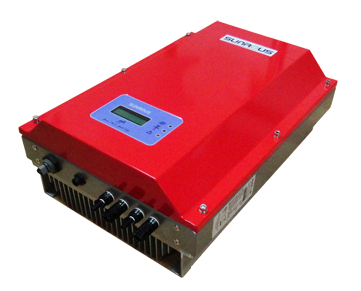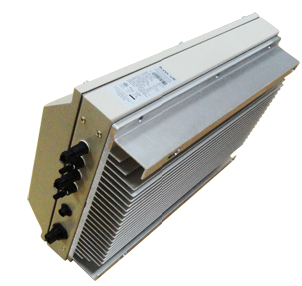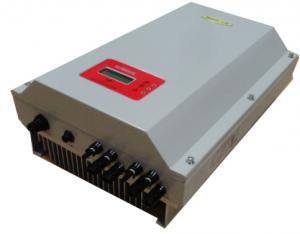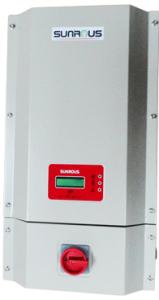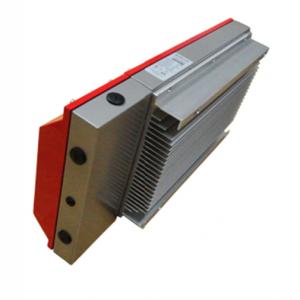Residential Solar Inverter with PV Grid-Tied Inverter Dual MPPT and Solar Panels
- Loading Port:
- Shanghai
- Payment Terms:
- TT or LC
- Min Order Qty:
- 10 mm
- Supply Capability:
- 1000 mm/month
OKorder Service Pledge
OKorder Financial Service
You Might Also Like
PV Grid-Tied Inverter Dual MPPT and Solar Panels
Datasheet:
GT4.0-ZX-01/HF | |
Input(DC) | |
Max.DC Power | 4000W |
Max.DC Voltage | 500V |
PV Voltage range, MPPT | 60V ~ 360V |
Max.input current | 30.0A |
Number of MPP trackers | 2 |
Max.number of strings (parallel) | 4 |
Output(AC) | |
Nominal AC power / | 4000W/4000W |
Max.output current | 16.0A |
Nominal AC Voltage / range | 180V~264V |
AC grid frequency / range | 47.5-51.5Hz / 59.3-60.5Hz |
Power factor at rated power | 1 |
THD | < 3% |
AC connection | Single-phase |
Efficiency | |
Max. efficiency/Californian efficiency | > 98.0% / > 97.0% |
MPP adaptation efficiency | > 99.0% |
Protection devices | |
DC reverse polarity protection | √ |
AC short-circuit protection | √ |
Ground fault monitoring | √ |
Grid monitoring | √ |
Output Transient Voltage Suppression | √ |
Over load | √ |
Anti-islanding | √ |
General data | |
Dimensions (W/ H / D) in mm | 370 / 540 / 185 mm |
Weight | 23kg |
Operating temperature range | -25 ~ +60℃ |
Storage temperature range | -40 ~ +70℃ |
Ambient humidity | 0 ~ 100% |
Consumption (night) | < 0.5W |
Topology | HF-transformer galvanic isolation |
Cooling concept | Convection |
Enclosure type | IP65 / NEMA 3R |
Features | |
DC connection: PV special connector | √ |
AC connection: connector | √ |
LCD display & Backlit | √ |
LED display | √ |
Interfaces: RS485 | √ |
Warranty: 10 years | √ |
Certificates & approvals | G83 / G59 / TUV / SAA / ETL / JET/ CE |
·High frequency transformer isolation and conversion efficiency rate up to 97%.
·Dual input sections with independent MPP tracking, allows optimal energy harvesting from two sub-arrays oriented in different directions
· High speed and precise MPPT algorithm for real time power tracking and improved energy harvesting, as well as regular MPP Adaptation Efficiency of over 99.0%.
·Flat efficiency curves ensure high efficiency at all output levels ensuring consistent and stable performance across the entire input voltage and output power range
·Wide input DC MPPT range(150V~550V)/output AC voltage range (180V~264V)
·IP 65/NEMA 3R, outdoor enclosure for unrestricted use under any environmental conditions
·Any modules can be used and fit in this device whether crystalline or thin-film.
·Use in residential applications requiring PV array plug-in grounding.
·RS-485 communication interface (designed for connection to computer or data-logger)
·Easy to install and operate with reduced weight.
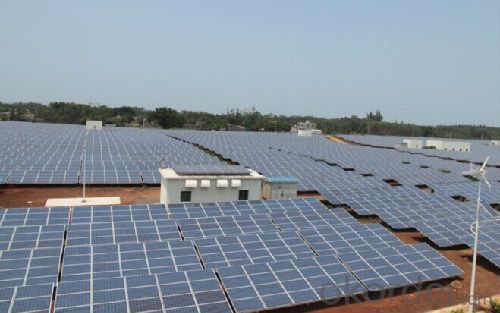
- Q: How does a solar inverter communicate with other components of a solar power system?
- A solar inverter communicates with other components of a solar power system through various means, such as wired or wireless connections. It typically exchanges information with components like solar panels, batteries, and grid-tie systems to coordinate and optimize the generation, storage, and distribution of solar energy. This communication includes exchanging data on power output, voltage levels, and system status, enabling efficient operation and monitoring of the entire solar power system.
- Q: How does a solar inverter handle voltage regulation in the grid?
- A solar inverter handles voltage regulation in the grid by constantly monitoring the voltage levels and adjusting its output accordingly. If the grid voltage is too high, the inverter reduces its output to prevent overloading and potential damage to connected devices. Conversely, if the grid voltage is too low, the inverter increases its output to compensate for the deficit and maintain a stable voltage supply. This regulation ensures that the solar energy generated by the inverter is seamlessly integrated into the grid while adhering to grid voltage standards.
- Q: What is the difference between a string inverter and a micro inverter?
- A string inverter is a type of solar inverter that is connected to a string of solar panels, converting the DC power generated by the panels into AC power for use in the electrical grid or in a building. On the other hand, a micro inverter is a smaller inverter that is installed on each individual solar panel, converting the DC power directly at the panel level. The main difference between the two is that a string inverter handles the power conversion for multiple panels in a series, while a micro inverter handles the power conversion for each individual panel separately. This means that micro inverters offer benefits such as increased energy production, better system monitoring, and improved safety, but they also tend to be more expensive compared to string inverters.
- Q: Can a solar inverter be used with a remote monitoring system?
- Yes, a solar inverter can be used with a remote monitoring system. Remote monitoring systems are designed to monitor and control the performance of solar inverters from a remote location. This allows users to track and analyze the solar energy production, detect any issues or faults in the inverter, and make necessary adjustments for optimal performance.
- Q: How does a solar inverter handle voltage and frequency variations caused by switching operations?
- A solar inverter is designed to handle voltage and frequency variations caused by switching operations through its built-in control mechanisms and advanced technology. When a solar inverter is connected to the grid, it monitors the voltage and frequency of the grid and adjusts its operation accordingly to maintain stability and safety. In the case of voltage variations caused by switching operations, a solar inverter typically employs a voltage control mechanism. This mechanism continuously monitors the voltage level of the grid and adjusts the output voltage of the inverter to match the grid voltage. If the grid voltage rises or falls beyond a certain threshold, the inverter automatically adjusts its output voltage to compensate and maintain a stable voltage level. Similarly, for frequency variations caused by switching operations, a solar inverter utilizes a frequency control mechanism. This mechanism constantly monitors the grid frequency and adjusts the inverter's output frequency to match the grid frequency. If the grid frequency deviates from the standard frequency, the inverter can quickly respond by adjusting its output frequency to maintain synchronization with the grid. To achieve this level of control, solar inverters often incorporate advanced digital signal processing algorithms and sophisticated control systems. These algorithms and control systems analyze the voltage and frequency signals from the grid, and based on predefined parameters, make rapid adjustments to the inverter's output to ensure compatibility with the grid. Ultimately, the goal of a solar inverter is to seamlessly integrate with the grid and provide a stable, reliable, and efficient power supply. By effectively handling voltage and frequency variations caused by switching operations, the inverter contributes to the overall stability and resilience of the grid, allowing for optimal utilization of solar energy and promoting a sustainable energy future.
- Q: How does a solar inverter handle voltage harmonics?
- A solar inverter handles voltage harmonics by using filtering techniques and advanced control algorithms. These methods help to smooth out the output voltage waveform, reducing or eliminating any unwanted harmonics.
- Q: How does a solar inverter handle voltage and frequency variations caused by load shedding?
- A solar inverter handles voltage and frequency variations caused by load shedding by constantly monitoring the grid conditions. When it detects a drop in voltage or frequency, it adjusts its output parameters accordingly to maintain a stable supply of electricity to the connected loads. This ensures that the devices receiving power from the solar inverter are not affected by the fluctuations in the grid caused by load shedding.
- Q: What are the key factors affecting the reliability of a solar inverter?
- The key factors affecting the reliability of a solar inverter include the quality and durability of its components, such as the semiconductor devices, capacitors, and transformers. The design and manufacturing processes also play a significant role, as well as the overall system integration and installation. The environmental conditions, such as temperature, humidity, and dust levels, can impact the inverter's reliability, along with the quality of the electrical grid and the stability of the solar power generation. Regular maintenance and monitoring are crucial for identifying and addressing any potential issues that may arise, ensuring the long-term reliability of the solar inverter.
- Q: What is the maximum efficiency rating of a solar inverter?
- The maximum efficiency rating of a solar inverter can vary depending on the model and manufacturer, but typically it ranges from 95% to 98%.
- Q: What are the potential risks of fire or explosions from a faulty solar inverter?
- The potential risks of fire or explosions from a faulty solar inverter include electrical malfunctions, overheating, short circuits, and insulation failures. These issues can lead to the accumulation of heat and energy, causing fires or explosions. Additionally, if the faulty inverter fails to properly regulate the flow of electricity, it can damage connected electrical devices or even cause electrocution hazards. Regular maintenance and inspections are crucial to minimize these risks and ensure safe operation of solar inverters.
Send your message to us
Residential Solar Inverter with PV Grid-Tied Inverter Dual MPPT and Solar Panels
- Loading Port:
- Shanghai
- Payment Terms:
- TT or LC
- Min Order Qty:
- 10 mm
- Supply Capability:
- 1000 mm/month
OKorder Service Pledge
OKorder Financial Service
Similar products
Hot products
Hot Searches
Related keywords
